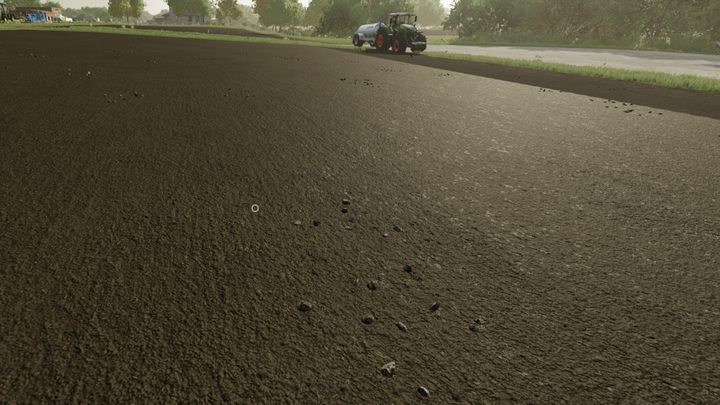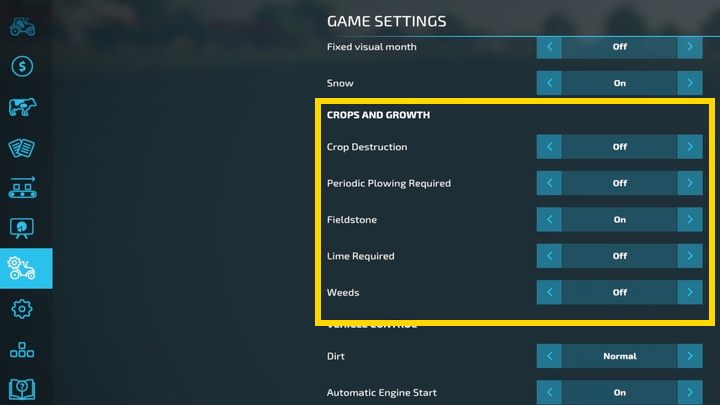Farming Simulator 22: Order of fieldwork
The following page of the Farming Simulator 22 guide describes the order of fieldwork.
Last update:
On this page of the guide to Farming Simulator 22, you can find a small summary of the order of works - what is plowing, cultivation, liming, or soil rolling for, which works are optional, and when to perform them. On the following pages of the guide, you can read about the details of specific fieldworks.

Basic works
The default order of work in the field is:
- Cultivation
- Sowing
- Harvesting.
This is enough for the majority of the grains. However, this approach will not ensure optimum yields.
Additional works
To maximize profits, you must perform the following work:
- Plowing - required for some root crops (e.g. potatoes), instead of cultivation. For example, you can plant corn without plowing, but the yield will be reduced by 15%. You can plow even if you sow grain - this will prevent the weeds from growing. Deep plowing will be done with a plow or a spader, while the shallower ones will be done with a subsoiler (it will not stop weeds from growing). By default, the game requires periodic plowing - ignoring this step will cause a decrease in yield by 15%. You can read more here - Plowing.
- Cultivation - it's not required if you've plowed. However, it is much easier and faster, so it should be used when there is no need for plowing the fields. You can use cultivators, mechanical and disc harrows (harrows are weaker - for example, they will not destroy oil radish, but they are lighter and faster in operation). Many seeders and planters have their own cultivator/harrow. The field must always be cultivated before sowing: you must either plow or cultivate. You can read more here - Cultivation.
- Lime spreading - it's a rare activity. If the field requires lime spreading, you will receive information about it on the field map or by personally checking the field. By default, lime spreading is a periodic activity. Ignoring it will lead to a decrease in yields by 15%. You will perform lime spreading with a fertilizer spreader from the store - it will have a lime icon in the list of supported materials. Lime spreading usually requires a newly formed field. Even if the field requires periodic lime spreading, you can still sow on it - this is an optional activity. You can read more here - Lime spreading.
- Stone picking - optional. The stones appear on the field after plowing/cultivation. You can collect them with stone pickers or ignore them. They do not affect the amount of harvest, but the rate of damage to equipment and vehicles working in the field. Soil rolling is the alternative. Read more about stone picking here: Stone picking.
- Soil rolling - a simple and fast process of pushing stones into the ground. It also allows you to level the field after plowing/cultivation - soil rolling ensures a higher yield by 5%. You can do soil rolling only with special rollers, before or after sowing, but before the growth of plants. Soil rolling is optional. You can read more here - Soil rolling.
- Sowing and planting - when the field is ready, you can start sowing grains or planting root crops. Most plants require seeders/planters from the basic set in the store, excluding potatoes. Pay attention to the type of machines - some have cultivators, others fertilizer spreaders. Equipment must be filled before work. You can read more here - Sowing and planting.
- Weeding - optional, but recommended. Weeds appear by default in the game. You can reduce the chance of them growing if the field was plowed deep. Weeds should be removed with a weeder or a herbicide. The weeder will only work when you use it in the first phase of plant growth (by default after a month). You can use the herbicide preventively and in the second phase of plant growth. Weeds reduce yield by 20%. You can read more here - Weeds and weeding.
- Fertilization - fertilization is optional, but very profitable. You can choose from many fertilization options - manure spreaders and natural fertilizers (manure or digestate from a biogas plant), artificial or natural fertilizer like slurry. Fertilization should be done twice to achieve maximum yield - not in one month but during the entire growth of plants. Fertilization provides the same bonus for the first and the same for the second fertilization. The field can be fertilized during sowing or before preparing it (even immediately after harvesting). You can't fertilize the fields when the plants are ready to harvest. Each of the two fertilizing processes increases the yield by 23%. You can read more here - Fertilization.
- Harvesting - it is done by using special harvesters. Harvesters with suitable headers are sufficient to harvest most plants. Special harvesters are required for - potatoes, sugar beets, cotton, garden plants. You can read more here - Harvesting.
- Mulchering - it's the process of shredding what's left of the harvest. It should be carried out immediately after harvesting and before other works (except for fertilizing). Mulchering is optional but it increases the next crop by 5%. You can read more here - Mulchering.
As you can see, to achieve maximum profits, you need to do a lot of work in one field. It is worth considering that a lot of time passes between harvesting and sowing, so you do not have to rush with work.

What can be turned off?
You can skip a lot of periodic work by turning it off in the settings:
- destroying crops by vehicle wheels,
- the need for periodic plowing,
- stones in the field,
- the need for lime spreading,
- weeds.
If you turn off these options while any of these elements are present, they will not disappear - if you turned off the weeds while they were in your fields, they will still remain there. Turning them off won't spawn any new ones.
- Farming Simulator 22 Guide
- Farming Simulator 22: Game Guide
- Farming Simulator 22: Field work
- Farming Simulator 22: How to buy field and what to pay attention to?
- Farming Simulator 22: Creating, merging and deleting fields
- Farming Simulator 22: Order of fieldwork
- Farming Simulator 22: Plowing
- Farming Simulator 22: Cultivation
- Farming Simulator 22: Lime spreading
- Farming Simulator 22: Stone picking
- Farming Simulator 22: Soil rolling
- Farming Simulator 22: Sowing and planting
- Farming Simulator 22: Weeds and weeding
- Farming Simulator 22: Fertilizing
- Farming Simulator 22: Harvesting
- Farming Simulator 22: Mulching
- Farming Simulator 22: Storing harvests
- Farming Simulator 22: Monitoring growth
- Farming Simulator 22: Field work
- Farming Simulator 22: Game Guide
You are not permitted to copy any image, text or info from this page. This site is not associated with and/or endorsed by the developers and the publishers. All logos and images are copyrighted by their respective owners.
Copyright © 2000 - 2025 Webedia Polska SA for gamepressure.com, unofficial game guides, walkthroughs, secrets, game tips, maps & strategies for top games.
